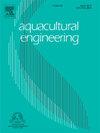The influence of length–width ratio of an unconventional mobile finfish structure on the drag force and dissolved oxygen: Laboratory experimentation and Computational Fluid Dynamics (CFD)
IF 4.3
2区 农林科学
Q2 AGRICULTURAL ENGINEERING
引用次数: 0
Abstract
Open ocean aquaculture (OOA) offers a number of benefits from inshore aquaculture, such as stronger currents and waves enhancing the water quality. However, conventional static aquaculture systems deployed in the open ocean do not resolve environmental issues such as the effects of heatwaves, or physical challenges such as extreme wave action. Farming fish in a mobile or semi-mobile system would have the advantage of being able to move fish to the best conditions for the fish year-round. The current study proposes an unconventional fin fish structure that could be deployed in the open ocean on either a single-point mooring (fixed), or as a fully mobile (mobile) system. The body of the structure is a square cross-section cylinder shape, covered by water-proof woven fabric cloth, and nets placed at the front and back of the body. This study considers how adjusting the length–width ratio, influences drag forces (important for a mobile scenario) as well as the dissolved oxygen (DO) inside the structure (important for a fixed scenario). This was achieved using flume experiments and Computational Fluid Dynamics (CFD). The volume of the structure is kept at 10,000 m3, current speed at 0.1 m/s and fish stocking density is 30 kg/m3 with the length–width ratio varying from 1 to 6. We found that when the length–width ratio increased, this resulted in the decrease of drag force and an increase of the unhealthy volume fraction (i.e. DO < 70 % of ambient DO) inside the structure, and vice versa. We also found that speed reduction caused by bio-fouling results in an increase of drag force and unhealthy volume fraction. Therefore, it is recommended that the design of mobile structures should balance the demands of the fish as well as the fish farmers which will be dependent on the operation (fixed or mobile).
一种非传统移动鳍鱼结构的长宽比对阻力和溶解氧的影响:实验室实验和计算流体力学(CFD)
开阔洋水产养殖(OOA)与近岸水产养殖相比有许多好处,如较强的洋流和海浪可提高水质。然而,在开阔海域部署的传统静态水产养殖系统无法解决环境问题,如热浪的影响,或物理挑战,如极端波浪作用。在移动或半移动系统中养殖鱼类的优势在于能够全年将鱼类转移到最适合鱼类生长的环境中。目前的研究提出了一种非常规的鳍鱼结构,既可以通过单点系泊(固定式),也可以作为完全移动(流动式)系统部署在大洋中。该结构的主体是一个正方形截面的圆柱体,由防水编织布覆盖,网放置在主体的前部和后部。本研究考虑了调整长宽比如何影响阻力(对移动方案很重要)以及结构内部的溶解氧(对固定方案很重要)。这是通过水槽实验和计算流体动力学(CFD)实现的。结构的体积保持在 10,000 立方米,流速为 0.1 米/秒,鱼类放养密度为 30 千克/立方米,长宽比从 1 到 6 不等。我们发现,当长宽比增加时,阻力减小,结构内的不健康体积分数(即溶解氧为环境溶解氧的 70%)增加,反之亦然。我们还发现,生物污损造成的速度降低会导致阻力和不健康体积分数增加。因此,建议移动结构的设计应平衡鱼类和养鱼户的需求,这将取决于运行方式(固定或移动)。
本文章由计算机程序翻译,如有差异,请以英文原文为准。
求助全文
约1分钟内获得全文
求助全文
来源期刊

Aquacultural Engineering
农林科学-农业工程
CiteScore
8.60
自引率
10.00%
发文量
63
审稿时长
>24 weeks
期刊介绍:
Aquacultural Engineering is concerned with the design and development of effective aquacultural systems for marine and freshwater facilities. The journal aims to apply the knowledge gained from basic research which potentially can be translated into commercial operations.
Problems of scale-up and application of research data involve many parameters, both physical and biological, making it difficult to anticipate the interaction between the unit processes and the cultured animals. Aquacultural Engineering aims to develop this bioengineering interface for aquaculture and welcomes contributions in the following areas:
– Engineering and design of aquaculture facilities
– Engineering-based research studies
– Construction experience and techniques
– In-service experience, commissioning, operation
– Materials selection and their uses
– Quantification of biological data and constraints
 求助内容:
求助内容: 应助结果提醒方式:
应助结果提醒方式:


